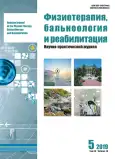The conceptual basis of non-invasive neuromodulation
- 作者: Voropaev A.A.1, Gerasimenko M.Y.2
-
隶属关系:
- National Medical Research Center for Rehabilitation and Balneology of the Ministry of Health of Russia
- Russian Medical Academy of Continuous Professional Education of the Ministry of Health of Russia
- 期: 卷 18, 编号 5 (2019)
- 页面: 280-285
- 栏目: Original studies
- URL: https://journals.rcsi.science/1681-3456/article/view/65301
- DOI: https://doi.org/10.17816/1681-3456-2019-18-5-280-285
- ID: 65301
如何引用文章
全文:
详细
Purpose. Based on the analysis of literature data and clinical studies, develop a conceptual framework for non-invasive neuromodulation based on the analysis of literature data and clinical studies, develop a conceptual framework for non-invasive neuromodulation.
Material and methods. A total 415 patients with various pathologies of the nervous system were studied. 105 patients with chronic brain ischemia 105 patients with consequences of intracranial trauma; 105 patients with dorsalgia; 105 patients with functional disorders of the nervous system (cephalgia, neurosis, menopausal disorders in women). All physical effects will be performed against the background of medical treatment in accordance with the MEA with the use of a pulse generator TETOS, a multifunctional device “Sedaton”, allowed for use in the territory of the Russian Federation.
Results. Clinical and neurophysiological study of patients (n = 415) with chronic brain ischemia, traumatic brain disease, pain syndromes, as well as functional disorders of the nervous system revealed the presence of signs of dysfunction of the limbic-reticular complex and mesodiencephalic structures of the brain according to electroencephalography et al. General pathogenesis mechanisms that determine the further direction of the disease (a tendency to chronization of the process, depletion of sanogenetic reserves), associated with the dysfunction of segmental and suprasegmental vegetative centers. The concept of non-invasive neuromodulation has been developed, which is based on a long-term study of various methods of neurostimulation in various groups of neurological patients
Conclusion. The neuromodulatory concept has defined the third (along with stimulation/activation and suppression/suppression) fundamental — modulatory approach to the treatment of diseases and injuries of the nervous system, and continues to develop dynamically along with the emergence of new technological solutions.
作者简介
Alexey Voropaev
National Medical Research Center for Rehabilitation and Balneology of the Ministry of Health of Russia
Email: mgerasimenko@list.ru
ORCID iD: 0000-0003-0944-8234
SPIN 代码: 4646-4268
PhD
俄罗斯联邦, MoscowMarina Gerasimenko
Russian Medical Academy of Continuous Professional Education of the Ministry of Health of Russia
编辑信件的主要联系方式.
Email: mgerasimenko@list.ru
ORCID iD: 0000-0002-1741-7246
SPIN 代码: 7625-6452
DSc, Professor
俄罗斯联邦, Moscow参考
- Gerasimenko MYu. Results of and prospects for the development of medical rehabilitation and balneology. Physiotherapy, balneology and rehabilitation. 2017;16(1):4-5. doi: 10.18821/1681-3456-2017-16-1-4-5. (In Russ.)
- Gerasimenko MYu. Features and differences of physiotherapy technologies in medical rehabilitation. Bulletin of Rehabilitation Medicine. 2013;5(57):9-14. (In Russ.).
- Gerasimenko MYu, Voropaev AA, Troshin VD. Non-invasive neuromodulation in the treatment of vascular cephalalgia. Materials of the Russian scientific-practical conference “Headache: topical issues of diagnosis, therapy and medical rehabilitation”. Moscow;2016:12-14. (In Russ.).
- Voropaev AA. The control program for the output parameters of the apparatus for transcranial electrostimulation. Certificate of registration of a computer program RUS 2003611167. (In Russ.)
- Voropaev AA. The program for controlling the output parameters of devices for low-frequency electro-magnetotherapy (STIM 7). Certificate of registration of a computer program RUS 2005611926. (In Russ.)
- Voropaev AA, Rudolf S. Transcranial electrostimulator (options) and a device for attaching electrodes of a transcranial electrostimulator. Patent for invention RU 2297253 C2, 04.20.2007. (In Russ.)
- Voropaev AA. A method for the treatment of neurosis. Patent for the invention RU 2300397 C2, 10.06.2007. (In Russ.)
- Voropaev AA, Gerasimenko MYu, Rachin AP. The use of transcranial electrical stimulation in patients with depressive-anxiety disorders. Physiotherapy, balneology and rehabilitation. 2016;5:244. (In Russ.)
- Voropaev AA. Efficacy of katadolon and cranial-spine electromagnetic neuromodulation in patients with discogenic radiculopathy. S.S. Korsakov Journal of Neurology and Psychiatry. 2008;108(10):67-70. (In Russ.)
- Voropaev AA, Troshin VD, Mochalov AD. Craniospinal electromagnetic therapy in the neurological practice. S.S. Korsakov Journal of Neurology and Psychiatry. 2007;107(12):16-21. (In Russ.)
- Voropaev AA, Spark DA, Luchenkov VV, Yastrebov DN. Chronic pain. Non-invasive neuromodulation. Moscow; 2017:17. (In Russ.)
- Ivanova GE. Medical rehabilitation in Russia. Development prospects. Consilium Medicum. 2016;18(2.1):9-13. (In Russ.)
- Ivanova GE. Organization of the rehabilitation process. Kremlin medicine. Clinical Herald. 2012;4:8-10. (In Russ.)
- Ivanova GE. Reconstructive treatment of patients with stroke. Russian Medical Journal. 2002;1:48. (In Russ.)
- Non-invasive neuromodulation of the central nervous system: Оpportunities and Challenges. Workshop Summary. Washington; 2015.
补充文件









